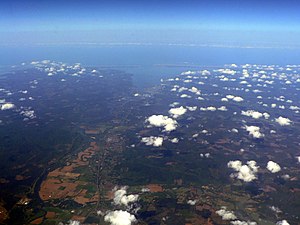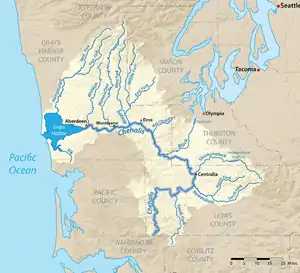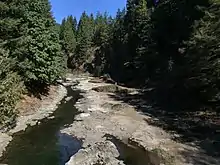Chehalis River (Washington)
The Chehalis River (/ʃəˈheɪlɪs/ shə-HAY-lis)[6] is a river in Washington in the United States. It originates in several forks in southwestern Washington, flows east, then north, then west, in a large curve, before emptying into Grays Harbor, an estuary of the Pacific Ocean. The river is the largest solely contained drainage basin in the state.
| Chehalis River | |
|---|---|
 Chehalis River Valley (left), Grays Harbor (middle distance) and Satsop River Valley (along bottom) | |
 Map of the Chehalis River watershed | |
 Mouth of the Chehalis River in Washington  Chehalis River (Washington) (the United States) | |
| Location | |
| Country | United States |
| State | Washington |
| Counties | Grays Harbor, Thurston, Lewis |
| Cities | Aberdeen, Centralia, Chehalis |
| Physical characteristics | |
| Source | |
| • location | Lewis County |
| • coordinates | 46°27′6″N 123°17′30″W[1] |
| • elevation | 1,000 ft (300 m)[2] |
| Mouth | Pacific Ocean |
• location | Grays Harbor, Aberdeen |
• coordinates | 46°57′29″N 123°50′5″W[1] |
• elevation | 0 ft (0 m)[2] |
| Length | 115 mi (185 km)[3] |
| Basin size | 2,660 sq mi (6,900 km2)[4] |
| Discharge | |
| • location | near Satsop, WA[5] |
| • average | 6,425 cu ft/s (181.9 m3/s)[5] |
| • minimum | 440 cu ft/s (12 m3/s) |
| • maximum | 47,000 cu ft/s (1,300 m3/s) |
| Discharge | |
| • location | mouth (Grays Harbor)[4] |
| • average | 11,208 cu ft/s (317.4 m3/s)[4] |
| Basin features | |
| Tributaries | |
| • right | South Fork Chehalis River, Newaukum River, Skookumchuck River, Satsop River, Wynoochee River, Wishkah River |
It was once much larger during the Ice Age when the tongue of the glacial ice sheet covering the Puget Sound terminated near Olympia and glacial runoff formed a large torrent of meltwater. This carved a large oversized valley that is much larger than the current river could have produced. The river's mouth was out near current Westport until rising sea levels at the end of the ice age flooded the broad Chehalis Valley to form a ria, known today as Grays Harbor.
History
Native American
The Quinault Indian Nation and the Confederated Tribes of the Chehalis Reservation are stakeholders of the river. Though the people ceded the lands surrounding the Chehalis River upon the signing of the 1856 Treaty of Olympia, the tribes have retained fishing and hatchery rights.[7]
December 3, 2007, floods
During the Great Coastal Gale of 2007, a 20-mile (32 km) stretch of Interstate 5 was closed between exits 68 and 88 because of flooding from the Chehalis River, causing the roadway to be under about 10 feet (3.0 m) of water. The recommended detour added about four hours and 280 miles (450 km).[8] It was not expected to reopen for several days.[9] However, upon breaching a dike on Dec. 5, 2007,[10] the water receded more quickly than anticipated. Amtrak train service between Portland, Oregon, and Vancouver, British Columbia, was also disrupted.[11] Washington governor Christine Gregoire declared a state of emergency on December 3.[12][13]
January 7, 2009, floods
During the January 7, 2009, Pacific Northwest storms, a 20-mile (32 km) stretch of Interstate 5 was closed between exits 68 and 88 because of flooding from the Chehalis River, causing the roadway to be under several feet of water. Since the main east–west mountain passes were also closed during this event, the flooding from the Chehalis River essentially cut off interstate traffic to the Puget Sound area from the south, and no detour was available.
Water rights
The Chehalis River, along with the Dungeness River, is part of only two river basins in Washington state that are granted protections and rights under "in-stream flow regulation". Passed in 1976, the law allows the river the right to maintain its own water levels. Unfettered access to the river is granted to grandfathered "senior" rights holders as they existed before the 1976 rule went into effect; the senior holders mostly consist of tribal communities and farmers. As of 2023, there are 93 recorded junior water rights holders, mostly homeowners, in the Chehalis basin.[14][15]
Course
The Chehalis River is the largest drainage basin completely within the state.[7] It begins at the confluence of the West Fork Chehalis River and East Fork Chehalis River, in southwestern Lewis County. From there the Chehalis flows north and east, collecting tributary streams that drain the Willapa Hills and other low mountains of southwestern Washington. The South Fork Chehalis River joins the main river a few miles west of the city of Chehalis. The Newaukum River joins the Chehalis River at Chehalis, after which the river turns north, flowing by the city of Centralia, where the Skookumchuck River joins. After Centralia, the Chehalis River flows north and west, collecting tributaries such as the Black River, which drains the Black Hills to the north, then in the Chehalis Gap collects the Satsop River and Wynoochee River, which drain the southern part of the Olympic Mountains.
The Wynoochee River joins the Chehalis near Montesano, after which the Chehalis River becomes increasingly affected by tides and widens into Grays Harbor estuary. The city of Aberdeen lies at the mouth of the Chehalis River. Just east of Aberdeen, the Wishkah River joins the Chehalis, and just west, between Aberdeen and Hoquiam, the Hoquiam River joins. At this point the river has become Grays Harbor. Before the estuary of Grays Harbor empties into the Pacific Ocean, the Humptulips River joins.

Flood control
Counties within the Chehalis River basin, various other regional governments, and the Washington Department of Fish and Wildlife (WDFW), in association with Native American tribes, environmental groups, scientists, and local citizens, organized a partnership in 2014 named the "Chehalis Basin Strategy" to propose and research a combination of plans along the Chehalis River to mitigate flooding and to restore aquatic habitat, particularly for local Chinook salmon.[16] The proposal outlines several flood control reduction measures, with downstream levee improvements particularly at the Centralia-Chehalis Airport, and a flood retention dam in Pe Ell which is planned to limit catastrophic damage from 100-year floods within the Chehalis River Basin.[17][18] The projects are to be carried out in three phases.
First phase
The first phases of the strategy began in 2012 and declared achieved in the early 2020s with a combined 140 flood and habitat projects completed at a cost of $152 million.[19]
The city of Hoquiam received a new pump house to replace an ineffective, aging pump. Completed in 2018 at a cost of $1.3 million, the modernized station protects the community's northern residential area, including an elementary school, and is considered a vital infrastructure project for future levee builds. Pipelines that direct the flow of floodwaters were also replaced. During a January 2022 flood, the rebuilt station pumped a combined 51,000,000 US gallons (190,000,000 L; 42,000,000 imp gal) of water without fail over 30 consecutive hours.[20]
The installation of log jacks in Montesano during 2018-2019 helped increase the riverbank of the migrating Wynoochee River, which was threatening the local wastewater plant that during flooding would have inundated the community with sewage runoff. The $2 million cost of the project was estimated to have saved over $40 million in future cleanup and containment efforts. The fortification increased the habitat of aquatic species and extended the operating life of the plant by several decades.[19]
Second and third stages
The second stage of the program was implemented soon thereafter and is focused on long-term solutions and strategy for flood control and financial backing of future tasks. The final phase is planned to begin in the mid-2020s and will target construction, additional financing, and devising long-term structural government oversight.[21]
Long-term projects
Part of the basin strategy is to remove artificial barriers and to restore forests and woodlands near the Chehalis River and its tributaries, to promote the habitats of aquatic species such as salmon, steelhead, and trout. As of 2023, the project, called the Aquatic Species Restoration Plan, has worked with an ongoing WDFW program begun in 2005 that has removed or reengineered 81 man-made impediments in the Chehalis basin at a cost of $27.6 million.[22]
Wildlife
The river is home to several salmon species, specifically Chinook salmon. A petition was filed by conservation groups in 2023 to list the Chinook salmon as endangered under the Endangered Species Act.[7]
See also
References
- U.S. Geological Survey Geographic Names Information System: Chehalis River, USGS, GNIS
- Google Earth elevation for GNIS coordinates.
- Chehalis River Archived March 30, 2005, at the Wayback Machine, The Columbia Gazetteer of North America
- Overview of the Chehalis River Basin Archived October 19, 2007, at the Wayback Machine, Chehalis River Council
- Water Resource Data, Washington, 2005, USGS.
- Phillips, James W. (1971). Washington State Place Names. University of Washington Press. ISBN 0-295-95158-3.
- Vander Stoep, Isabel (May 24, 2023). "Federal 'Endangered' Listing Sought for Chehalis River's Spring Chinook, Others". The Chronicle (Centralia, Washington). Retrieved June 23, 2023.
- "Lane Of I-5 Could Reopen For Commercial Vehicles Tonight". KPTV, Associated Press. Archived from the original on 2007-12-05. Retrieved 2007-12-06.
- "I-5 near Chehalis may be shut down for days". KATU, Associated Press. Archived from the original on 2007-12-06. Retrieved 2007-12-04.
- "WSDOT crews to breach dike to help drain flood waters from I-5". KATU, Associated Press. Archived from the original on 2007-12-09. Retrieved 2007-12-06.
- "Rain floods streets; mudslides shut down Amtrak". The News Tribune. Retrieved 2007-12-06.
- "Proclamation by the Governor" (PDF) (Press release). State of Washington Office of the Governor. December 3, 2007. Archived from the original (PDF) on February 27, 2008. Retrieved 2007-12-05.
- "Proclamation by the Governor" (PDF) (Press release). State of Washington Office of the Governor. December 3, 2007. Retrieved 2017-07-11.
- Vander Stoep, Isabel (May 25, 2022). "Headwaters to Harbor: What are Water Rights? Why Does Lewis County Care?". The Chronicle. Retrieved July 25, 2023.
- Vander Stoep, Isabel (July 24, 2023). "'Critical' low flows in Chehalis River Basin threaten aquatic species, agriculture". The Chronicle. Retrieved July 25, 2023.
- "Learn about how you can help ensure a prosperous future for the Chehalis Basin". Chehalis River Alliance. Retrieved July 27, 2023.
- "Chehalis Basin Strategy". Chehalis Basin Strategy. Retrieved June 27, 2023.
- Eric Rosane; Claudia Yaw (July 21, 2021). "$70 Million Chehalis Basin Board Budget Stalled". The Chronicle. Retrieved July 25, 2023.
- The Chronicle staff (September 6, 2023). "Chehalis Basin Strategy progress in review: Log jacks protect wastewater treatment plant in Grays Harbor County". The Chronicle. Retrieved August 28, 2023.
- The Chronicle staff (September 15, 2023). "Chehalis Basin Strategy progress in review: Pump station paves way for economic revitalization, flood protection in Grays Harbor County". The Chronicle. Retrieved September 22, 2023.
- The Chronicle staff (July 3, 2023). "Chehalis Basin Strategy Submits Status Report to Washington State Legislature". The Chronicle. Retrieved July 18, 2023.
- The Chronicle staff (September 29, 2023). "Chehalis Basin Strategy progress in review: Improving fish passage on Middle Fork Wildcat Creek in Grays Harbor County". The Chronicle (Centralia, Washington). Retrieved October 2, 2023.
External links
- USGS Chehalis River Basin map
- USGS Chehalis River Basin schematic diagram
- U.S. Geological Survey Geographic Names Information System: East Fork Chehalis River, USGS, GNIS
- U.S. Geological Survey Geographic Names Information System: West Fork Chehalis River, USGS, GNIS
- U.S. Geological Survey Geographic Names Information System: South Fork Chehalis River, USGS, GNIS